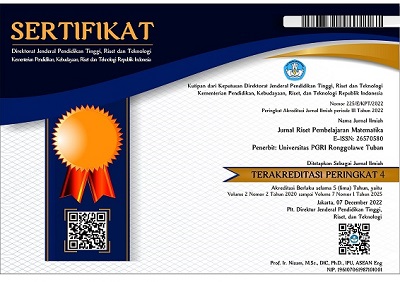Analisis Kesalahan Siswa MTs yang Mempunyai Gaya Belajar Visual dalam Menyelesaikan Masalah Matematika Berdasarkan Newman-Stages
DOI:
https://doi.org/10.55719/jrpm.v5i1.586Keywords:
matematika, Pemecahan Masalah, gaya belajar, prosedur newman, analisis kesalahanAbstract
This study aims to describe the types and causes of errors in grade VII students of MTs Manbail Huda Jenu Tuban who have a visual learning style in solving mathematical problems with flat shapes based on Newman's stages. This type of research is explorative qualitative. The errors studied were based on the criteria in the Newman procedure stage. The main instrument is the researcher, while the supporting instruments are problem solving test sheets, and interview guidelines. The research subjects were seventh grade students of MTs Manbail Huda Jenu Tuban who had a visual learning style. The instrument to determine the visual learning style is a learning style test. The subjects interviewed were selected from students who have a visual learning style by paying attention to the ability to express their thoughts orally and in writing. Three students were interviewed with visual learning styles. The results of the analysis show that the types of errors students who have a visual learning style tend to make errors in processing skills (process skill errors) and writing errors in answers (encoding errors). Factors that cause student errors are because students are not confident in solving problems, forget in the steps or process of working and write the final answer that is not in accordance with the question asked and in a hurry to work and lack of accuracy in solving the problem.
Downloads
References
Amalia, R., Aufin, M., & Khusniah, R. (2018). Analisis Kesalahan Dalam Menyelesaikan Soal Cerita pada Pokok Bahasan Persamaan Linier Berdasarkan Newman Kelas X-Mia di SMA Bayt Al-Hikmah Kota Pasuruan. Seminar Nasional Matematika dan Pendidikan Matematika, II, 346-359.
Deporter, B, & Hernacki, Mike. (2011). Quantum Learning. Bandung, Indonesia : Kaifa.
Ekayanti, A. (2017). DIAgnosis Kesalahan Mahasiswa Dalam Proses Pembuktian Berdasarkan Newmann Error Analysis. Jurnal “Mosharafah”, 6(1): 105-116. http://e-mosharafa.org/index.php/mosharafa
Kurniawati, P, R., Hadi, R,F. (2021) Analisis Kesalahan Siswa Sekolah Dasar dalam Menyelesaikan Masalah Matematika Berdasarkan Newman. Aksioma Jurnal Program Studi Pendidikan Matematika, 10(2): 891-902. http://dx.doi.org/10.24127/ajpm.v10i2.3530
Moleong, L.J. (2011). Metodologi Penelitian Kualitatif. Bandung, Indonesia : PT Remaja Rosdakarya
Prakitipong, N. & Nakamura, S. (2006). Analysis of Mathematics Performance of Grade Five Students in Thailand Using Newman Procedure. Journal of In-ternational Cooperation in Education, 9(1): 111-122. https://cice.hiroshima-u.ac.jp/wp-content/uploads/publications/Journal9-1/9-1-9.pdf
Rusman. (2012). Belajar dan Pembelajaran Berbasis KomputerMengembangkan Profesionalisme abad 21. Bandung, Indonesia : Alfabeta.
Sugiyono. (2015). Metode Penelitian Kuantitatif, Kualitatif dan R & D. Bandung, Indonesia : Alfabeta.
Sukmawaty. (2017). Analisis Kesalahan Berbahasa Indonesia Pada Skripsi Maha-siswa Program Studi Sistem Informasi Sekolah Tinggi Manajemen Informat-ika Dan Komputer (Stmik) Kharisma Makassar. Jurnal Retorika, 10(1): 56-65. https://ojs.unm.ac.id/retorika/article/view/4617
Syah, M. (2014). Psikologi Pendidikan dengan Pendekatan Baru. Bandung,Indonesia : PT. Remaja Rosdakarya.
Wahyuni, Y. (2017). Identifikasi Gaya Belajar (Visual, Auditorial, Kinestetik) Mahasiswa Pendidikan Matematika Universitas Bung Hatta. Jurnal Penelitian dan Pembelajaran Matematik, 10(2): 128-132. https://jurnal.untirta.ac.id/index.php/JPPM/article/view/2037
Downloads
Published
How to Cite
Issue
Section
License
Copyright (c) 2023 Jurnal Riset Pembelajaran Matematika

This work is licensed under a Creative Commons Attribution-ShareAlike 4.0 International License.
Penulis yang menerbitkan dengan jurnal ini menyetujui persyaratan berikut:
- Penulis mempertahankan hak cipta dan memberikan jurnal hak publikasi pertama dengan karya yang dilisensikan secara bersamaan di bawah Lisensi Internasional Creative Commons Attribution-ShareAlike 4.0 yang memungkinkan orang lain untuk berbagi karya dengan pengakuan kepenulisan karya dan publikasi awal di jurnal ini.
- Penulis dapat membuat pengaturan kontrak tambahan yang terpisah untuk distribusi non-eksklusif dari versi jurnal yang diterbitkan dari karya tersebut (misalnya, mempostingnya ke repositori institusional atau menerbitkannya dalam sebuah buku), dengan pengakuan publikasi awalnya di jurnal ini.
- Penulis diizinkan dan didorong untuk memposting karya mereka secara online (misalnya, di repositori institusional atau di situs web mereka) sebelum dan selama proses pengiriman, karena dapat menghasilkan pertukaran yang produktif, serta kutipan lebih awal dan lebih besar dari karya yang diterbitkan.









